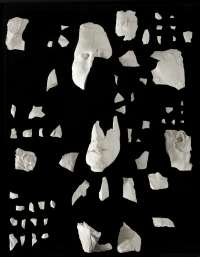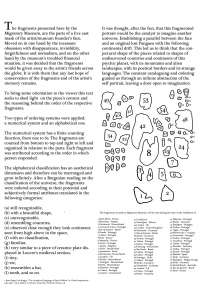The fragments presented here by the Migratory Museum, are the parts of a live cast mask of my face. Moved on in one hand by the incessant obsession with disappearance, invisibility, forgetfulness and nomadism, and on the other hand by the museum’s troubled financial situation, it was decided that the fragments would be given away to the artist’s friends across the globe. It is with them that any last hope of conservation of the fragments and of the artist’s memory remains.
To bring some orientation to the viewer this text seeks to shed light on the piece’s context and the reasoning behind the order of the respective fragments.
Two types of ordering were applied: a numerical system and an alphabetical one.
The numerical system has a finite counting function, from one to 62. The fragments are counted from bottom to top, right to left and organized in relation to the parts. Each fragment was attributed to a location according to the order in which each person responded.
The alphabetical classification has an aesthetical dimension and therefore can be rearranged and grow infinitely. After a Borgesian reading on the classification of the universe, the fragments were ordered according to their potential and subjectively formal attributes translated in the following categories:
• still recognizable,
• with a beautiful shape,
• unrecognizable,
• resembling countries
• observed close enough they look continents seen from high above in the space,
• with no classification,
• familiar,
• very similar to a piece of ceramic plate displayed in Louvre’s medieval section,
• tiny,
• etc,
• resembles a hat,
• tooth,
and so on…
It was thought, after the fact, that this fragmented portrait would be the catalyst to imagine another universe. Establishing a parallel between the face and an original lost Pangea with the following continental drift. This led us to think that the conjectural shape of the pieces related to shapes of undiscovered countries and continents of this psychic planet, with its mountains and alien landscapes, with its poetical borders and its strange languages. The constant cataloguing and ordering guided us through an infinite abstraction of the self portrait, leaving a door open to imagination.
The fragments presented here by the Migratory Museum, are the parts of a live cast mask of my face. Moved on in one hand by the incessant obsession with disappearance, invisibility, forgetfulness and nomadism, and on the other hand by the museum’s troubled financial situation, it was decided that the fragments would be given away to the artist’s friends across the globe. It is with them that any last hope of conservation of the fragments and of the artist’s memory remains.
To bring some orientation to the viewer this text seeks to shed light on the piece’s context and the reasoning behind the order of the respective fragments.
Two types of ordering were applied: a numerical system and an alphabetical one.
The numerical system has a finite counting function, from one to 62. The fragments are counted from bottom to top, right to left and organized in relation to the parts. Each fragment was attributed to a location according to the order in which each person responded.
The alphabetical classification has an aesthetical dimension and therefore can be rearranged and grow infinitely. After a Borgesian reading on the classification of the universe, the fragments were ordered according to their potential and subjectively formal attributes translated in the following categories:
• still recognizable,
• with a beautiful shape,
• unrecognizable,
• resembling countries
• observed close enough they look continents seen from high above in the space,
• with no classification,
• familiar,
• very similar to a piece of ceramic plate displayed in Louvre’s medieval section,
• tiny,
• etc,
• resembles a hat,
• tooth,
and so on…
It was thought, after the fact, that this fragmented portrait would be the catalyst to imagine another universe. Establishing a parallel between the face and an original lost Pangea with the following continental drift. This led us to think that the conjectural shape of the pieces related to shapes of undiscovered countries and continents of this psychic planet, with its mountains and alien landscapes, with its poetical borders and its strange languages. The constant cataloguing and ordering guided us through an infinite abstraction of the self portrait, leaving a door open to imagination.

